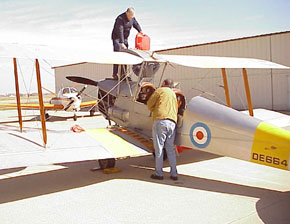Follow Us x
As with the Avro 504, the Tiger Moth ranks as one of the most famous military training aircraft ever built. Derived from the highly successful civilian DH 60G Gipsy Moth, the Tiger Moth differed from its predecessor in having staggered and swept-back wings (which enabled the parachute-equipped occupant to exit the aircraft in a hurry), an inverted engine to aid visibility over the nose and strengthening to the wings and fuselage in order to allow the aircraft to operate at a higher all up weight.
Designated the DH82, the prototype completed its maiden flight on 26 October 1931 and entered service with the RAF the following month. De Havilland further improved the trainer three years later when it mated the more powerful Gipsy Major engine with a slightly modified Tiger Moth fuselage (wooden rear fuselage decking in place of fabric), the new version being designated the DH82A. The final variant to reach series production was the winterized DH82C, built by de Havilland Aircraft of Canada.
A staple trainer for virtually all Allied air arms during World War 2, over 8500 Tiger Moths were eventually built. The aircraft remains a firm favorite today, particularly in those countries in which it was in service. Now on display at Frontiers of Flight Museum in Dallas.

First Flight Date: 26 October 1931
Surviving Airworthy Variants: DH 82, SH 82A and DH 82C
Specifications:
Length: 23 ft 11 in (7.29 m)
Wingspan:29 ft 4 in (8.94 m)
Height: 8 ft 9.50 in (2.68 m)
Weights:
Empty:1115 lb (506 kg)
Max: T/.O 1770 lb (803 kg)
Performance:
Max Speed: 109 mph (175kmh)
Range: 302 miles (486 km)
Power plant: de Havilland Gipsy lll (DH 82) or Gipsy Major (DH82B/C)
Output: DH 82 120hp (89 k, DH 82B
130 hp (97 kW), DH 82C 145 hp (108 kW)
